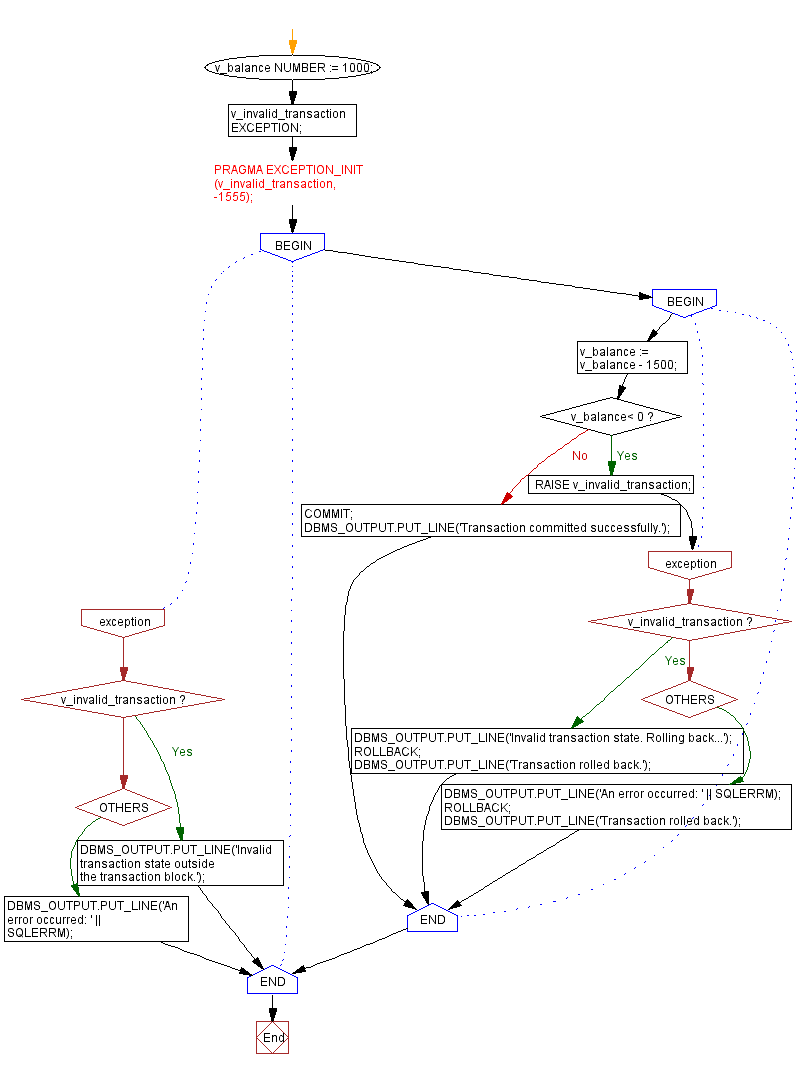Handling INVALID_TRANSACTION exception in PL/SQL with Example Code
PL/SQL Exception Handling: Exercise-12 with Solution
Handle the INVALID_TRANSACTION exception when a transaction is in an invalid state.
Sample Solution:
PL/SQL Code:
DECLARE
v_balance NUMBER := 1000;
v_invalid_transaction EXCEPTION;
PRAGMA EXCEPTION_INIT(v_invalid_transaction, -1555);
BEGIN
BEGIN
v_balance := v_balance - 1500;
IF v_balance< 0 THEN
RAISE v_invalid_transaction;
END IF;
COMMIT;
DBMS_OUTPUT.PUT_LINE('Transaction committed successfully.');
EXCEPTION
WHEN v_invalid_transaction THEN
DBMS_OUTPUT.PUT_LINE('Invalid transaction state. Rolling back...');
ROLLBACK;
DBMS_OUTPUT.PUT_LINE('Transaction rolled back.');
WHEN OTHERS THEN
DBMS_OUTPUT.PUT_LINE('An error occurred: ' || SQLERRM);
ROLLBACK;
DBMS_OUTPUT.PUT_LINE('Transaction rolled back.');
END;
EXCEPTION
WHEN v_invalid_transaction THEN
DBMS_OUTPUT.PUT_LINE('Invalid transaction state outside the transaction block.');
WHEN OTHERS THEN
DBMS_OUTPUT.PUT_LINE('An error occurred: ' || SQLERRM);
END;
/
Sample Output:
Invalid transaction state. Rolling back... Transaction rolled back.
Explanation:
The said code in Oracle's PL/SQL that demonstrates the handling of the INVALID_TRANSACTION exception and raised when a transaction enters an invalid state, such as an attempt to commit a transaction with a negative balance.
A variable v_balance is initialized with the value 1000. An exception v_invalid_transaction is defined using the PRAGMA EXCEPTION_INIT to associate it with the Oracle error code -1555, which indicates an invalid transaction state.
Inside the nested BEGIN block, when it attempts to deduct 1500 from the balance (v_balance). If the resulting balance is negative (v_balance< 0), it raises the v_invalid_transaction exception.
Then it displays a message indicating an invalid transaction state, rolls back the transaction, and displays a message confirming the rollback.
The WHEN OTHERS exception raised, displays an error message with SQLERRM, rolls back the transaction, and confirms the rollback.
Flowchart:

Go to:
PREV : Handling CASE_NOT_FOUND exception in PL/SQL with example code.
NEXT : Handling SUBSCRIPT_BEYOND_COUNT exception in PL/SQL.
Have another way to solve this solution? Contribute your code (and comments) through Disqus.
What is the difficulty level of this exercise?
